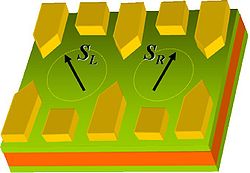
Loss-DiVincenzo quantum computer
Encyclopedia

Semiconductor
A semiconductor is a material with electrical conductivity due to electron flow intermediate in magnitude between that of a conductor and an insulator. This means a conductivity roughly in the range of 103 to 10−8 siemens per centimeter...
-based quantum computer
Quantum computer
A quantum computer is a device for computation that makes direct use of quantum mechanical phenomena, such as superposition and entanglement, to perform operations on data. Quantum computers are different from traditional computers based on transistors...
proposed by Daniel Loss
Daniel Loss
Daniel Loss is a professor of Theoretical Condensed Matter Physics at the University of Basel. With David P. DiVincenzo , he proposed the Loss-DiVincenzo quantum computer in 1997, which would use electron spins in quantum dots as qubits....
and David P. DiVincenzo in 1997. The proposal was to use as qubits the intrinsic spin-1/2 degree of freedom of individual electrons confined to quantum dots. This was done in a way that fulfiled DiVincenzo Criteria for a scalable quantum computer , namely:
- identification of well-defined qubits;
- reliable state preparation;
- low decoherence;
- accurate quantum gate operations and
- strong quantum measurements.
Implementation of the two-qubit gate
The Loss-DiVincenzo quantum computer operates, basically, using inter-dot gate voltage for implementing Swap (computer science)Swap (computer science)
In computer programming, the act of swapping two variables refers to mutually exchanging the values of the variables. Usually, this is done with the data in memory...
operations and local magnetic fields (or any other local spin manipulation) for implementing the Controlled NOT gate
Controlled NOT gate
The Controlled NOT gate is a quantum gate that is an essential component in the construction of a quantum computer. It can be used to disentangle EPR states...
(CNOT gate).
The Swap operation is achieved by applying a pulsed inter-dot gate voltage, so the exchange constant in the Heisenberg Hamiltonian becomes time-dependent:

This description is only valid if:
- the level spacing in the quantum-dot
 is much greater than
is much greater than  ;
; - the pulse time scale
 is greater than
is greater than  , so there is no time to happen transitions to higher orbital levels and
, so there is no time to happen transitions to higher orbital levels and - the decoherence time
 is longer than
is longer than  .
.
From the pulsed Hamiltonian follows the time evolution operator

We can choose a specific duration of the pulse such that the integral in time over
 gives
gives  and
and  becomes the Swap operator
becomes the Swap operator  .
.The CNOT gate may be achieved by combining
 (square root of Swap) operations with individual spin operations:
(square root of Swap) operations with individual spin operations:
This operator gives a conditional phase for the state in the basis of
 .
.
